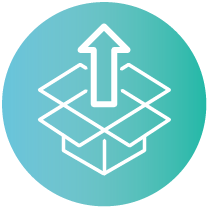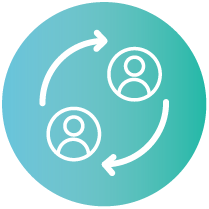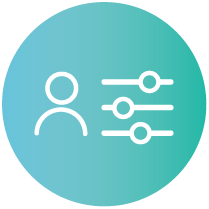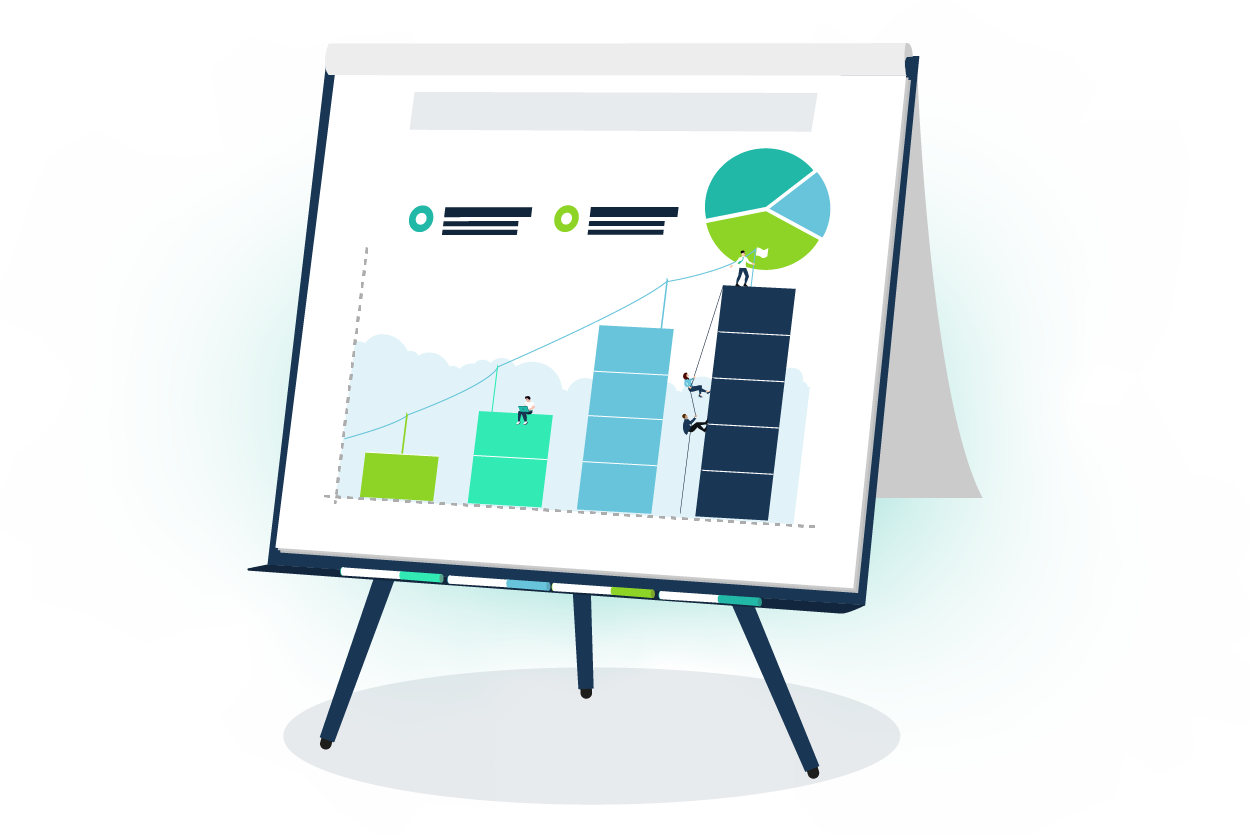
Guesswork is appropriate if you’re selecting lottery numbers, but the realm of organisational learning demands a more precise approach. This is where learning data and data-driven decision-making comes into its own.
As Dr. Mike Schmoker puts it, ‘things get done only if the data we gather can inform and inspire those in a position to make a difference’.
As a learning professional, you are in a position to make a difference. You just need to be armed with the right information.
Thankfully, there’s no shortage of data to aid your decision-making. Estimates suggest that 238 terabytes of data are generated across the world every day.
This number only continues to grow. In fact, it is estimated that 90% of the world’s data was generated in the last two years alone. All you need now are the tools to collect this information and the know-how to analyse it effectively.
Marketers use data to adapt to audience trends, personalise content, improve output and demonstrate ROI. Why shouldn’t learning and development teams follow suit?
Over the course of this article, we’ll explore the role data plays in a learning initiative, the metrics you should track, how to collect the information you need and how to overcome common challenges. As a result, you’ll transform into a data-driven learning expert.
The Power of Data
Data is information, usually in the form of facts and figures, that can be analysed to guide decision-making. But what does the research tell us about decision-making itself? Which is more reliable: trusting our instincts, relying on experience or following the data?
- According to PwC research, data-driven organisations are 3x more likely to report significant improvements in decision-making
- An EY survey shows that 81% of businesses agree that data should be at the heart of all decision-making.
- Despite this, 62% of executives still rely more on experience and advice than data to make decisions.
- According to Splunk, 55% of organisational data is ‘dark’. This means it’s untapped or completely unknown.
This tells us a few things. Data-driven decisions create better outcomes. This is something we all seem to recognise and yet we still have a tendency to fall back on what we know, or what’s easy. There’s also an issue with data visibility and data collection.
This is something we’ll explore further over the course of this article. For now, however, let’s examine how data can impact your learning and development programmes.
The Role of Learning Data

As you might expect, data plays a pivotal role in organisational learning and development. What you may not expect, however, is just how many different ways it can support your efforts.
- Needs Analysis: You can’t conduct a proper training needs analysis without collecting the right data. This analysis is an essential first step for creating a structured workplace learning programme. It helps you to examine performance metrics and pinpoint gaps in employee skills. You can then use this information to establish a focus for your training initiative.
- Personalised Learning: Effective data analysis empowers you to tailor your learning experiences to suit individual needs. You should keep a close eye on your learners’ progress and preferences in order to offer personalised learning pathways. This process can be conducted manually or automated seamlessly via a recommendation system.
- Performance Monitoring: Learning data helps to facilitate the real-time monitoring of learner performance. This enables you to assess whether your training programme is on the right track. You can also identify struggling learners and intervene proactively. This is a great opportunity to provide targeted support that improves individual and organisational performance.
- Pilots & Testing: If you’re rolling out a significant learning programme, then it’s usually a good idea to start with a pilot and conduct user acceptance testing. Gathering feedback data at this stage helps to identify potential issues before a full rollout. You can then make timely adjustments that help to ensure a more effective full-scale implementation.
- Automation: Data serves a crucial role in automating tricky and time-consuming administrative tasks. This can include managing course enrollments, sharing certificates, user provisioning, organising content groups, generating reports and so on. That frees you up to focus on actioning your learning strategy and generating learner engagement.
- Compliance: Your data also plays a crucial role in tracking and documenting compliance training. When it comes to regulatory requirements, you can’t just cross your fingers and hope for the best. You need to know that your employees have the certifications and qualifications necessary to operate in their roles. Data provides a welcome sense of certainty and security.
- Learner Feedback: Learner feedback data gives you a sense of your audience’s general sentiment. Your learners have valuable insights to share. In fact, their suggestions can help you to refine your learning strategy and improve decision-making. You can collect feedback data via surveys, happy sheets, focus groups, check-ins or other online platforms.
As we’ve seen, data wears a variety of different hats when it comes to supporting learning and development processes. Next up, let’s explore the specific benefits that arise from leveraging this data.
The Benefits of Learning Data
As Francis Bacon wisely noted, ‘knowledge is power’. For learning professionals, that knowledge comes in the form of reliable data. This is your strategic advantage. It offers you the opportunity to go beyond the numbers in order to generate real value.
Here are 6 benefits that arise from data-driven decision-making.
1. Establishing Trends

Without data, you’ve got no way of identifying patterns and recurring behaviours over time. You’re completely in the dark. In turn, this means you won’t be able to perform a comparative analysis to identify learner trends.
For instance, without data you’d never know that mobile usage is growing year-on-year. That’s useful information to know if you want to meet your learners on the platforms they are already using.
2. Resource Optimisation

Learning and development departments are often saddled with limited budgets. Unsure where to allocate your training funds? Then leverage data-driven insights to guide effective resource allocation and improve your return on investment.
After all, this data can help to reveal areas of need and areas where you can make a meaningful impact. Armed with these insights, you’ll be in a position to make better informed decisions.
3. Enhanced Engagement

You can’t change behaviour or improve performance without an engaged audience. Data analysis on your training content, platform usage metrics and learner feedback can identify engagement blockers.
You can then adjust your approach accordingly. Why not consider introducing or improving your gamification strategy or social learning setup?
4. Better Decisions

With the right data at your fingertips, you’ll make informed decisions that are grounded in genuine insight. In turn, this will lead to better learning outcomes.
After all, you’ll be able to see where your current programme is working and where it’s falling short. You can then make improvements as necessary to help increase its impact.
5. Skill Gap Closure

Once you’ve used data to identify your skills shortages, you can then use it to help close the gap. After all, you’ll be able to create personalised learning initiatives and monitor your progress at every stage.
Resolving a skills gap will have a profound impact on your organisation. In fact, it can lead to increased productivity, enhanced innovation and improved job satisfaction.
6. Proving Your Value

According to a LinkedIn Workplace Report, only 8% of CEOs say they see any business impact from their L&D programmes. This means one of two things: either the work you’re doing isn’t moving the dial, or it’s going completely unnoticed.
Thankfully, your data can help to demonstrate the value of your initiatives to your stakeholders. Just don’t show up to battle unarmed. Come locked and loaded with quantifiable data points to ensure you can justify every decision and highlight your successes.
Ultimately, higher levels of engagement and better decision-making leads to improved outcomes. Indeed, if you commit to data-driven decisions, you’ll soon create a feedback loop for continuous improvement.
Regular analysis will help you to refine your learning experiences to meet both your learners’ and your organisation’s needs and expectations. What’s more, there’s a good chance this will lead to the creation of a learning culture.
The Role of Intuition
Whilst we’re data advocates, we do recognise that intuition and experience still have a role to play. Indeed, Harvard Business School research has shown that ‘gut feelings’ are useful in situations where further data gathering won’t aid the decision-making process.
As researcher Laura Huang puts it, ‘In several studies I’ve conducted, I found that the role of gut feel is often to inspire a leader to make a call, particularly when the decision is risky.’
In some respects, intuition is akin to pattern recognition. It can help you navigate through tricky situations and solve problematic puzzles. You’ll need to rely on it in cases where you either have too little or too much information to work with.
That said, when it comes to organisational learning and development, the stakes are high. You’re responsible for the professional development of your employees and helping your organisation to achieve its goals.
If you find yourself making too many decisions based on your gut feelings, then it’s probably time to go back to the drawing board.
Key Metrics to Track

Now we’ve seen the benefits of a data-driven approach, it begs the question: what data should you be tracking? What are the metrics that matter as a learning professional?
These metrics are your means to quantifying the effectiveness of your training programmes. But where to start? After all, there’s a lot of data to sort through. And if you’re not monitoring the right information, it won’t meaningfully support your decision-making.
Start by asking yourself what you’re trying to achieve. Your choice of metrics should closely align with your organisation’s goals and objectives. You should also consult with your stakeholders to make sure you’re tracking the right data.
After this, you can then keep an eye on the following datasets:
1. Learning Outcomes
These metrics focus on measuring the effectiveness of your training programmes. They include completion rates, pass rates, progress in learning paths, skill acquisition, retention rates and time to competency.
In short, this data tells us how your training programme is impacting organisational knowledge and skill sets, without showcasing the impact on behaviour and performance.
2. Performance Analytics
These metrics go beyond completion rates and satisfaction scores to highlight your training programme’s impact against your organisational goals.
Here, you’ll be monitoring platform engagement, social engagement, performance improvements, changes in operational efficiency, your cost per learner and your overall return on investment. You can also benchmark this data against industry standards.
3. Learner Feedback
These metrics revolve around collecting feedback from your learners so you can assess their satisfaction with your content, delivery and platforms. You can establish a Net Promoter Score (NPS) for your training programme, or use a different approach.
This helps you to understand if your initiatives are truly resonating with your audience. Following this, you can then pinpoint opportunities for improvement.
There’s also a variety of operational metrics to monitor — but that’s a conversation for another time. Some of this data is harder to collect than others. For instance, training ROI is notoriously difficult to track.
As such, it’s vital that you set yourself up for success and are able to track your progress. Remember to focus on the data that will lead to better decision-making, not the data that’s easiest to collect and analyse.
Collecting Learning Data
Every interaction with your training programme generates a new data point. But how do you collect this information, so you can analyse it at a later date?
In reality, your L&D data will come from a variety of sources. After all, there’s a good chance you provide a diverse set of online and offline training experiences. In general, however, these are likely to be your key data sources:
- Learning Management Systems: Modern learning systems have reporting features that help you to track learner engagement, progress and completion rates.
- Instructor-Led Training Attendance: For face-to-face sessions or virtual training, you’ll need to manually track data on attendance, participation and completion.
- Skill and Competency Assessments: Assessments can be used to provide insights into competency levels and the practical application of skills in the workplace.
- Performance Reviews: Performance reviews and manager feedback can offer a broader perspective on the impact of training on job performance.
- Surveys and Feedback Forms: Direct input from learners through surveys, feedback forms and interviews can be the source of valuable qualitative data.
- Control Groups: You can also set up control groups to test a hypothesis. For instance, the impact of training on sales performance or customer satisfaction.
Bringing all this information together will enable you to form a comprehensive understanding of the impact of your training programmes. However, the fun doesn’t have to stop there. Let’s explore how technology can support you further.
Embracing Technology

You’re not all alone with your data. Software solutions can support you in collecting, utilising and analysing all this information. As a result, you’ll be empowered to make better data-driven decisions. Let’s delve into a few different solutions.
- Data Visualisation Tools: As we’ve seen, you’ve got a lot of data to work with. Making sense of all this information isn’t easy. Thankfully, there’s plenty of tech that can help. By integrating with a data visualisation tool, you’ll be able to transform complex L&D data into visually comprehensible charts, graphs and dashboards.
- Learning Record Stores & xAPI: A Learning Record Store (LRS) is a repository that stores learning data collected from various sources in a standardised format. Moreover, if you utilise the xAPI standard, then you’ll be able to store and track a broader range of learning activities, including mobile learning, social learning and real-world experiences.
- Integrations: API integrations can help to expedite numerous administrative processes and avoid human error. For instance, you could integrate with your HR platform to provide a holistic view of employee development, talent acquisition and workforce planning. That way you can ensure your learning programmes align with HR strategies.
- Artificial Intelligence: Your data can also be used to feed AI algorithms. These algorithms analyse large datasets to identify patterns, recommend personalised learning paths and predict future learning needs. You can even create chatbots powered by AI that are capable of providing instant support and mentorship to your learners.
Learning Data Challenges
There are various challenges that you should be aware of (and ready to overcome) when it comes to L&D data and large datasets in general. Your awareness of these issues can help you to navigate these complexities and drive towards informed decisions.
- Data Quality: Learning initiatives and environments evolve, so it’s important to keep your data current. Outdated or obsolete data can lead to inaccurate analysis and poor decisions. To overcome this difficulty, you should monitor your datasets carefully and remove any that are showing signs of age.
- Data Literacy: When you embarked on a career as a learning professional, you probably didn’t anticipate that you’d be handling so much data. Interpreting this information requires a certain degree of proficiency. As such, lean on tools that help you to visualise your data effectively and don’t be afraid to ask for help.
- Data Paralysis: It turns out you can have too much of a good thing. An abundance of data can lead to us feeling overwhelmed and uncertain. If you’re feeling stuck, you should reassess your objectives, goals and priorities. Set aside any inessential information and use your instinct if necessary.
- Data Tunnel Vision: There’s also the chance that we can get a little too obsessed with our data, to the detriment of everything else. Failing to consider the broader context of your learning programme, organisation and industry can lead to data tunnel vision. You should always consider how other factors can impact your success.
- Data Privacy and Security: Collecting and storing learner data raises privacy concerns. You should ensure that you’re adhering to data protection regulations. You’ll also need to establish security measures to safeguard any sensitive data. If you’re unsure, then seek out your organisation’s Data Protection Officer for support.
Final Word
Being a learning professional requires navigating challenging pathways that are shrouded in uncertainty. In the not too distant past, guesswork and trial-and-error were often the order of the day. But data-driven decision-making can help the fog to clear.
Your learning data supports a variety of different processes, from needs analysis to personalised pathways and performance analysis. As we’ve seen, using this data effectively can lead to a multitude of benefits.
You should take care to consider your objectives, select your key metrics and locate your data sources. Achieve this, and you’ll be rewarded with an easier decision-making process and better learning outcomes. Ultimately, the data speaks for itself.
Thank you for reading. Effective data analysis and decision-making is just one part of your role as a learning professional. For further tips and support download ‘The L&D Professional’s Handbook’ now!









